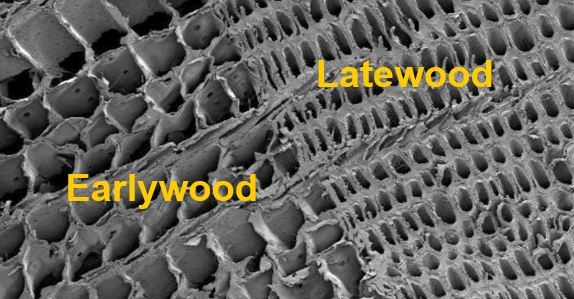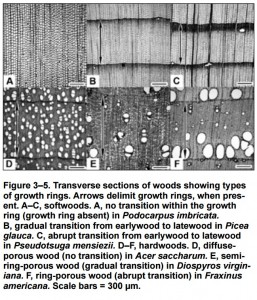
In this post I am building upon Dan’s earlier discussion of the misconceptions surrounding growth rate and wood density. This post extends the discussion to include virtually all wood species.
“Rate of growth” can be expressed as either changes in ring width or the speed of growth of the tree. In this blog post we are only concerned with ring width.
In most cases there is little or no correlation between ring width and wood density. The only species where a relationship might – repeat might – exist are softwoods such as spruce and hardwoods such as the deciduous oaks. Confusingly, however, the relationship is not consistent between these two groups. In the former group fast growth sometimes produces low density timber whereas the opposite relationship can occur in the latter group.
Confused? Don’t worry you are not alone. As we shall see, many commonly held assumptions about growth rate and density are incorrect.
Most tree species form their wood tissue in growth increments which are correlated with annual or seasonal climatic changes. Wood formed at the beginning of the growth period is termed ‘earlywood’, while wood formed later is known as ‘latewood’. Earlywood is usually paler in colour and less dense than latewood due to differences in the type and thickness of conducting cells.
In tree species that form distinct growth rings there are three fundamental patterns of earlywood and latewood within the growth ring:
- No change in cell type across the growth ring
- A gradual reduction of the inner diameter of conducting cells from the earlywood to the latewood
- An abrupt and distinct change in the inner diameter of conducting cells from the earlywood to the latewood
These patterns appear in both softwood and hardwood species although there is a difference in how they are manifested due to the contrasting anatomical structures of these two botanical categories.
Consequently, wood species can be divided into six groups (three softwood and three hardwood) on the basis of their growth ring characteristics when seen in a transverse cross section. The six groups can be illustrated as follows and are summarized in the table below.
(From Chapter 3 of USDA Wood handbook: Wood as an engineering material)
Table. Growth rate and wood density relationships
- Softwood species with no visible growth rings (e.g. some tropical and southern temperate timbers including most species in the Podocarpaceae, Cupressaceae and Andcupressaceae families). In these species there is no correlation between growth rate and wood density.
- Softwood species where the growth rings have a gradual transition from earlywood to latewood (e.g. the spruces and the firs). In these species growth of the denser latewood part of the growth ring is relatively constant irrespective of climate, whereas the earlywood part varies from year to year. This means that that a wider ring has more of the less dense earlywood and so density might decrease with increasing growth rate. The relationship is not consistent, however, as the density of a given ring width is affected by the genetic makeup and growing conditions of a tree, and can also be influenced by its stage of development. Therefore, particularly for timber of mixed origins, ring width alone is not an accurate predictor of wood density.
- Softwood species where the growth rings have an abrupt transition from earlywood to latewood (e.g. the larches and the hard pines). In these species there is no correlation between growth rate and wood density.
- Hardwood species where the growth rings have fairly evenly distributed vessels meaning that there is little difference between earlywood and latewood. (These species are termed ‘diffuse porous hardwoods’ and include most tropical hardwoods along with temperate species such as the birches and the evergreen oaks.) In these species there is no correlation between growth rate and wood density.
- Hardwood species where the growth ring characteristics are intermediate between ring porous and diffuse porous. (These species are termed ‘semi-diffuse porous hardwoods’ and include European walnut.) In these species there is little correlation between growth rate and wood density.
- Hardwood species where the growth rings have earlywood cells of greater diameter than those formed later in the growing season. (These species are termed ‘ring porous hardwoods’; they are always deciduous and include European oak and European ash.) In these species, the width of the low density earlywood part of the growth ring fairly consistent, irrespective of the growing conditions, whereas the width of the denser latewood varies from year to year. This means that fast growth tends to produce a higher proportion of high density latewood. Within limits, fast growth produces relatively dense, strong timber and vice versa.
Not all timber species neatly fit into the six categories listed above. Teak and hickory, for example, can be either semi-diffuse porous or ring porous depending upon the growth conditions.
If you want to find out more about these relationships, have a look at the following textbooks which should be stocked in most university wood science libraries:
- BARNETT, J. and JERONIMIDIS, G. (eds) (2003). Wood quality and its biological basis. Blackwell Publishing: Oxford; Malden, MA; Victoria, Australia.
- TSOUMIS, G. (1991). Science and technology of wood; structure, properties, utilization. Van Nostrand Reinhold: New York.
- WIEDENHOEFT, A. and MILLER R. (2005). ‘Structure and function of wood’ In: ROWELL, R. (ed) Handbook of wood chemistry and wood composites. Taylor and Francis: Boca Raton; London; New York, Singapore.


Leave a Reply
You must be logged in to post a comment.